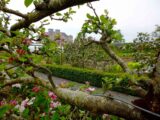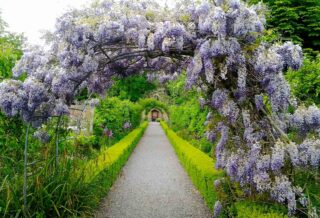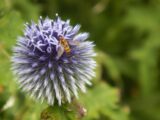Portumna Castle’s Gardens
Portumna Castle is one of very few remaining semi-fortified Jacobean Manor Houses in Ireland. It was built by the Fourth Earl of Clanricarde (1573-1635) and his wife Frances Walsingham, Countess of Essex (d.1632). The build was completed by 1618 and this year we celebrate 400 years of its existence.
The imposing facade of the castle faces north and is approached by a long avenue passing through three formal gardens and aligned gateways. The Lady's Garden closest to the house is planted with old bush roses, which flower throughout the month of June, surrounded by box hedging and clipped bay lollipop trees. The second walled garden has wide formal paths, lawns and specimen trees including black walnuts. Through a small doorway to the side of this space is the entrance to the old kitchen garden, walled-in and over an acre in size.

This garden was run for over 15 years as a community garden led by local horticulturist Ruth Carty. They planted fruit trees and bushes, and put in a polytunnel, flower beds and vegetable beds. They grew the fruit and vegetables for sale locally and maintained the space. When Ruth retired, it was decided by the OPW to take on a craft gardener, myself, Lynn O’Keeffe-Lascar in 2015.
Since then the focus of the garden has changed, it is now about the visitor experience, providing lots of colour, scent and interest from Easter to Halloween. I have added hundreds of bulbs to existing beds and borders, to flower in time from when the castle opens at Easter; these include Thalia daffodils, multi-stemmed scented hyacinths, blue and white cammasias, irises, tulips and finally alliums.
The main paths follow the original layout as found by the archaeologists when the garden was surveyed. That is a wide path approx. 4m in from the walls all around the whole garden and a central path. The south and west walls, lined with flower beds, are faced with red brick to hold the heat of the sun while the north and east walls are stone and are planted up with a large shrubbery and mixed fruit plantings. The central path is flanked by box hedging, narrow herbaceous borders either side and mature espalier trained apples. These trees burst into pink and white blossoms in May, before the herbaceous borders flower for the rest of summer.

Worth seeing in flower is the well-established wisteria archway that fills the garden with scent in mid-May, the mini woodland that has a carpet of primroses and bulbs in early spring and the large vegetable garden planted up with potatoes, herbs, peas, sweetcorn and pumpkins in summer. Of particular interest to children is the willow maze that grows taller and taller as the summer progresses. There are sunny bench seats along the south-facing wall, and shady arbours in the woodland and even a thatched gazebo with a large pergola over cobbles draped in grapes.

I have a strong focus on wildlife wherever I garden, my original horticultural training was in organic production, and I still follow those principles when possible. I have put in a small pond that is regularly used by birds to wash, including goldcrests, and I hope to see frog spawn in it soon too. I have a pair of robins (sometimes three but that usually causes consternation) who follow the gardeners around all the time hoping we’ll dig something up for them. The garden buzzes with bumblebees, honey bees and butterflies, and I follow the advice of the National Pollinator Plan. This includes choosing flowering plants that best suit the bees, single flowers instead of doubles, areas of long grass, and having lots of flowers in the garden all year round. There are several native black honey bee colonies on site, which are being monitored by NUIG. These wild bees are very special to us, and are minded on-site through the protection of their hives, and by growing lots of bee-friendly crops such as phacelia, linseed and sunflowers, as well as hazel and willow. In return, the bees are very well behaved, pollinate the strawberries, raspberries and pumpkins, and haven’t stung anyone yet!
Lynn O’Keeffe-Lascar has a DSc in Amenity Horticulture from Greenmount College, Antrim. She has extensive experience in community gardening, fruit and vegetable growing.
